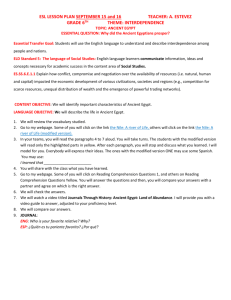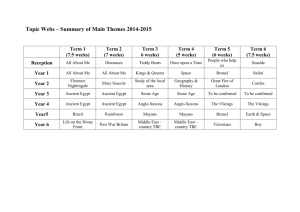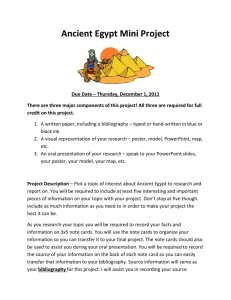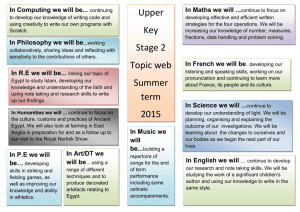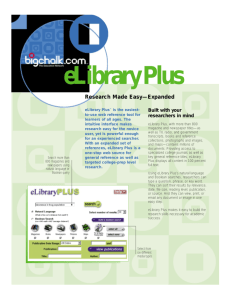Ancient Egypt Alphabet Book
advertisement
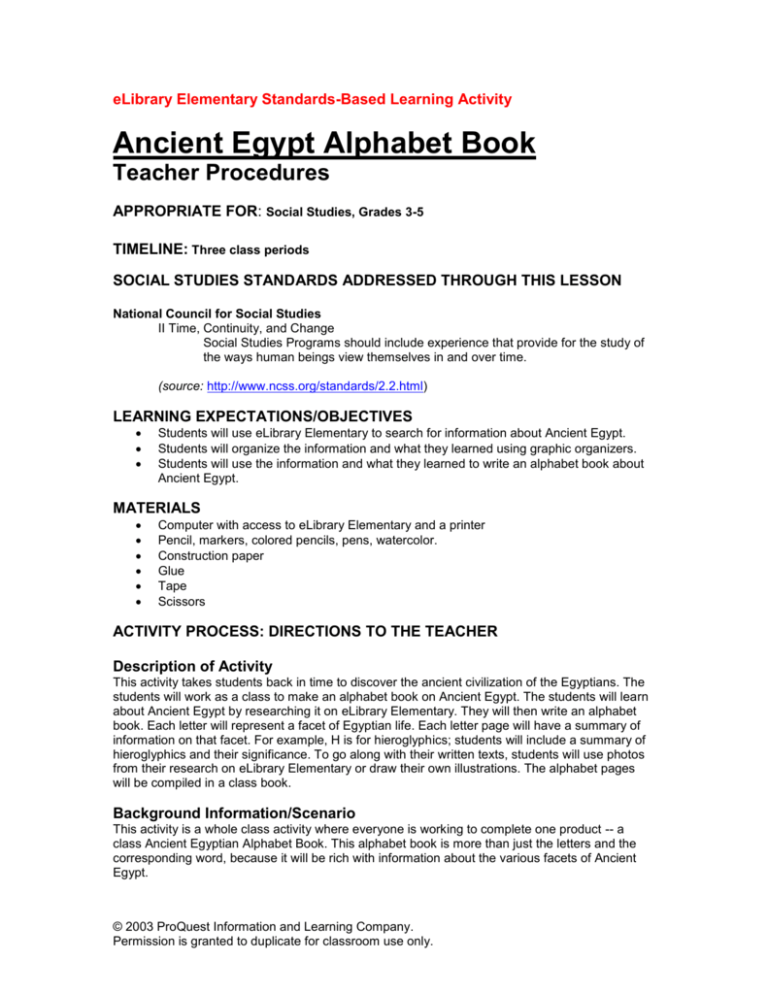
eLibrary Elementary Standards-Based Learning Activity Ancient Egypt Alphabet Book Teacher Procedures APPROPRIATE FOR: Social Studies, Grades 3-5 TIMELINE: Three class periods SOCIAL STUDIES STANDARDS ADDRESSED THROUGH THIS LESSON National Council for Social Studies II Time, Continuity, and Change Social Studies Programs should include experience that provide for the study of the ways human beings view themselves in and over time. (source: http://www.ncss.org/standards/2.2.html) LEARNING EXPECTATIONS/OBJECTIVES Students will use eLibrary Elementary to search for information about Ancient Egypt. Students will organize the information and what they learned using graphic organizers. Students will use the information and what they learned to write an alphabet book about Ancient Egypt. MATERIALS Computer with access to eLibrary Elementary and a printer Pencil, markers, colored pencils, pens, watercolor. Construction paper Glue Tape Scissors ACTIVITY PROCESS: DIRECTIONS TO THE TEACHER Description of Activity This activity takes students back in time to discover the ancient civilization of the Egyptians. The students will work as a class to make an alphabet book on Ancient Egypt. The students will learn about Ancient Egypt by researching it on eLibrary Elementary. They will then write an alphabet book. Each letter will represent a facet of Egyptian life. Each letter page will have a summary of information on that facet. For example, H is for hieroglyphics; students will include a summary of hieroglyphics and their significance. To go along with their written texts, students will use photos from their research on eLibrary Elementary or draw their own illustrations. The alphabet pages will be compiled in a class book. Background Information/Scenario This activity is a whole class activity where everyone is working to complete one product -- a class Ancient Egyptian Alphabet Book. This alphabet book is more than just the letters and the corresponding word, because it will be rich with information about the various facets of Ancient Egypt. © 2003 ProQuest Information and Learning Company. Permission is granted to duplicate for classroom use only. This activity is best done when students have already started a unit on Egypt and have acquired some knowledge on the subject. It can be done after the teacher or the whole class has brainstormed a list of all the things the students already know about Ancient Egypt and what they want to know. It would be helpful to gather any books from the library on Ancient Egypt to have available in your room before this activity starts. Give time for students to peruse the books before the activity starts. Put letters of the alphabet into a hat and let students pick a letter. This activity is great for a classroom with various abilities and levels. Based on their current knowledge, have students make a list of just some of the facets of Egypt that might correspond to their letter. This will focus their research on eLibrary Elementary. For example, S could be “symbols,” “scarabs” or “sphinx.” Outline of Procedures – Day One 1. Students will decide what information they will try to look for which corresponds to their letter. For example, a student might look for papyrus paper for “P” or complete a time line of historical dates for “T.” 2. Students will gather as much information about their letter topic by doing searches on eLibrary Elementary. To search eLibrary Elementary: Go to eLibrary Elementary. Click the Topics tab at the top of the page. Under the Archaeology category heading, click Featured Cultures. Click Ancient Egypt. 3. Students will print out as much information as they can and use My List functionality to save their links. (Remember, before leaving the eLibrary Elementary session, students must print out or email their My List links.) 4. Using any graphic organizer of their choice (or teachers may select one for students to use), students will organize their information. Go to the following bigchalk Editor's Choice Web site for graphic organizers: http://www.sdcoe.k12.ca.us/score/actbank/sorganiz.htm Outline of Procedures: Day Two 5. Students will write their first drafts of their letter topic. Lengths of descriptions may vary depending on the topic, as well as the amount of information. (Students must write a concise, informative description of approximately one page.) 6. Students will pair up with a partner. The pair of students will read their descriptions to each other. For tips on coaching students to listen to each other and provide feedback, go to the following bigchalk Editor's Web choice: http://www.storyarts.org/classroom/retelling/coaching.html. Students will give feedback on each other’s descriptions. Students will check each other’s spelling, punctuation and help determine their paragraph construction. 7. Students will write a final version of their letter topic with the changes. © 2003 ProQuest Information and Learning Company. Permission is granted to duplicate for classroom use only. Outline of Procedures: Day Three 8. Students will create their letter page for the class alphabet book on Ancient Egypt. Student will use a picture from eLibrary Elementary or they will draw a picture. Students must draw their letter at one top corner (probably the right, depending on how you plan to bind the book together). Students can choose to decorate their letter and letter page. Glue on the picture or illustration on the page or draw it directly on the page. Students will either write their final draft on the letter page or they will type it up and glue it down. Students will then give the finished piece to their teacher. Have two students volunteer to make the cover. Conclusion/Finished Work Teacher compiles the letter pages into a bound class book. Teachers will laminate the book if possible to protect the book throughout the school year. It would be great to make photocopies of the book for all students to keep. ASSESSMENT Students will be evaluated based on the following: Did the student use eLibrary Elementary to collect information on their letter topic? Did the student effectively organize information? Did the student write a concise, informative description of their topic (one page)? Did the writing demonstrate a strong understanding of the topic? For example, if they wrote on mummies, did they write about the process of mummification and the reasons behind it? OPTIONAL EXTENDED ENRICHMENT ACTIVITIES Ancient Egypt Daily Life: Have each student write his or her own story about a day in Ancient Egypt. Their story must be at least five paragraphs long. They will write as if they were telling about their own life in Egypt over the course of one day. They cannot be the pharaoh, a king or queen or a god. They can be a priest, worker, soldier, merchant, slave, or visitor. They can work alone or in small groups. Source: bigchalk Editor's Choice Web site: http://members.aol.com/Donnclass/Egyptlife.html Barter: Have a mock bazaar by collecting items to barter, such as pencils and stickers. The Egyptians ranked the value of their wares according to the "deben," a standard-sized piece of copper. A goat may have been worth one deben, and a bed 2.5 deben. A reasonable trade would be two or three goats for one bed. Prepare for the activity by assigning each item a deben value. A cherry lollipop might be six deben, a small lemon flavored candies one deben, etc. Have each child take inventory prior to trading to calculate the total value of their starting worth. Let them trade. Have the kids recalculate. Source: bigchalk Editor's Choice Website: http://members.aol.com/Donnclass/Egyptlife.html Archeology: Use magazines or the Internet to look up places around the world where archeologists are at work today. Make a large world map to show findings. Focus this study on Egypt and archaeological digs in Egypt over time. Plus: Debate the ethics of taking artifacts from a tomb for museums. Write a want ad for pyramid workers. Compare the height of some of the world’s highest structures to the pyramids. Find pieces of literature you think should be left as examples, like the Rosetta Stone. © 2003 ProQuest Information and Learning Company. Permission is granted to duplicate for classroom use only. Ancient Egypt Alphabet Book A Social Studies Lesson DURING THIS ACTIVITY YOU WILL… Pick a letter of the alphabet out of a hat. Pick a topic from Ancient Egyptian life that corresponds with this letter. Use eLibrary Elementary to search for information about your topic. Organize the information and what you learned using graphic organizers. Use the information and what you learned to write a concise, informative description of that topic. Create a “letter page”: your letter and the summary of the letter topic. DAY ONE 1. Decide what information you will try to look for which corresponds to your letter. For example, you might look for papyrus paper for “P” or do a time line of historical dates for “T.” 2. Gather as much information about your letter topic by doing searches on eLibrary Elementary. To search eLibrary Elementary: Go to eLibrary Elementary. Click the Topics tab at the top of the page. Under Archaeology, click Featured Cultures. Click Ancient Egypt. 3. You will print out as much information as you can – pictures, articles, definitions, maps, timelines, facts -- and use the “My List” option to save the articles you want to use. Make sure you email yourself you’re my List options or email them to yourself to save them before you leave eLibrary Elementary! 4. Organize your information with a graphic organizer. DAY TWO 5. Write the first draft of your letter topic. Lengths of descriptions may vary depending on topic, as well as amount of information. You must write an informative description about one page long. 6. Pair up with a partner. You will read your descriptions to each other. Give feedback on each other’s descriptions. Check each other’s spelling, punctuation, and help determine their paragraph construction. 7. You will write a final version of your letter topic with the changes. © 2003 ProQuest Information and Learning Company. Permission is granted to duplicate for classroom use only. DAY THREE 8. Create your letter page for the class alphabet book on Ancient Egypt. You will use a picture off of eLibrary Elementary or draw a picture. Please draw your letter at the top corner, where your teacher shows you. You can choose to decorate your letter and letter page. Glue on your picture or illustration or draw right on the page. Either write your final draft on the letter page or type it up and glue it down. Give the finished piece to your teacher. Think about volunteering to make the cover. If interested, tell your teacher. Assessment You will be evaluated based on the following: Did you use eLibrary Elementary to collect information on your letter topic? Did you organize your information well? Did you write a concise, informative description of your topic (about one page)? Based on your writing, did you indicate a strong understanding of the topic? For example, if you wrote about mummies, did you write about the process of mummification and the reasons behind it? © 2003 ProQuest Information and Learning Company. Permission is granted to duplicate for classroom use only.
